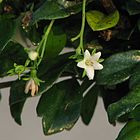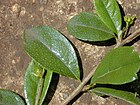Note: This is a project under development. The articles on this wiki are just being initiated and broadly incomplete. You can Help creating new pages.
Difference between revisions of "Carmona retusa"
| (One intermediate revision by the same user not shown) | |||
| Line 1: | Line 1: | ||
[[File:Starr-010425-0048-Carmona retusa-flower and fruit-Haiku-Maui (23904296114).jpg|thumb|right|''Carmona retusa'']] | [[File:Starr-010425-0048-Carmona retusa-flower and fruit-Haiku-Maui (23904296114).jpg|thumb|right|''Carmona retusa'']] | ||
'''Carmona retusa''' is an evergreen shrub or much-branched small tree. It can grows up to 4 metres tall. The plant ranks among the top 10 of medicinal plants with potential in the Philippines, and thus a small-scale industry has developed around it. It is sometimes grown, especially in the Philippines, for the leaves which are used as a tea substitute and for medicinal purposes. It is also often grown as an ornamental and hedge plant and is a popular subject for bonsai. This plant belongs to Ehretia mcrophylla family. | '''Carmona retusa''' is an evergreen shrub or much-branched small tree. It can grows up to 4 metres tall. The plant ranks among the top 10 of medicinal plants with potential in the Philippines, and thus a small-scale industry has developed around it. It is sometimes grown, especially in the Philippines, for the leaves which are used as a tea substitute and for medicinal purposes. It is also often grown as an ornamental and hedge plant and is a popular subject for bonsai. This plant belongs to Ehretia mcrophylla family. | ||
| − | |||
==Uses== | ==Uses== | ||
| − | {{Uses|}}, {{Uses|}}, {{Uses| | + | {{Uses|Stomach problems}}, {{Uses|Dysentery}}, {{Uses|Coughs}}. |
==Parts Used== | ==Parts Used== | ||
| − | {{Parts Used|}}. | + | {{Parts Used|Fruits}}. |
==Chemical Composition== | ==Chemical Composition== | ||
| − | <ref name="chemical composition"/> | + | The plant has been shown to contain a range of medically active constituents. |
| + | The leaves contain rosmarinic acid, flavonoid glycosides and triterpenoids.<ref name="chemical composition"/> | ||
==Common names== | ==Common names== | ||
| − | {{Common names|sa=|en=|gu=|hi=|kn=Ele-adike soppu, Ennebuddi gida|ks=|ml=|mr=|pa=|ta=|te=}} | + | {{Common names|sa=|en=Cilon boxwood|gu=|hi=Phala|kn=Ele-adike soppu, Ennebuddi gida|ks=|ml=|mr=|pa=|ta=Kuruvingi|te=Bappanaburi, Baranki}}<ref name="Common names"/> |
==Properties== | ==Properties== | ||
| Line 31: | Line 31: | ||
==Habit== | ==Habit== | ||
| − | {{Habit|}} | + | {{Habit|Evergreen shrub}} |
==Identification== | ==Identification== | ||
| Line 50: | Line 50: | ||
==Mode of Propagation== | ==Mode of Propagation== | ||
| − | {{Propagation|}} | + | {{Propagation|Cuttings of young shoots}}, {{Propagation|Seeds}}. |
==How to plant/cultivate== | ==How to plant/cultivate== | ||
| − | <ref name="How to plant/cultivate"/> | + | The plant has escaped from cultivation in Hawaii and become naturalized in secondary vegetation.<ref name="How to plant/cultivate"/> |
==Commonly seen growing in areas== | ==Commonly seen growing in areas== | ||
| Line 71: | Line 71: | ||
<references> | <references> | ||
| − | <ref name="chemical composition">[ | + | <ref name="chemical composition">[http://www.sphinxsai.com/2017/ch_vol10_no6/2/(565-574)V10N6CT.pdf Chemical constituents]</ref> |
| − | <ref name="Leaf">[" | + | <ref name="Leaf">[Morphology]</ref> |
| + | <ref name="Common names">Karnataka Aushadhiya Sasyagalu By Dr.Maagadi R Gurudeva, Page no:45</ref> | ||
| − | <ref name="How to plant/cultivate">[ | + | <ref name="How to plant/cultivate">[http://tropical.theferns.info/viewtropical.php?id=Carmona+retusa Cultivation]</ref> |
</references> | </references> | ||
==External Links== | ==External Links== | ||
| − | * [ ] | + | * [https://indiabiodiversity.org/species/show/32490 Carmona retusa on indiabiodiversity.org] |
| − | * [ ] | + | * [https://www.bonsaiempire.com/tree-species/carmona Carmona retusa on bonsaiempire.com] |
| − | * [ ] | + | * [https://pfaf.org/user/Plant.aspx?LatinName=Carmona+retusa Carmona retusa on pfaf.org] |
[[Category:Herbs]] | [[Category:Herbs]] | ||
[[Category:Herbs]] | [[Category:Herbs]] | ||
Latest revision as of 08:27, 6 August 2020
Carmona retusa is an evergreen shrub or much-branched small tree. It can grows up to 4 metres tall. The plant ranks among the top 10 of medicinal plants with potential in the Philippines, and thus a small-scale industry has developed around it. It is sometimes grown, especially in the Philippines, for the leaves which are used as a tea substitute and for medicinal purposes. It is also often grown as an ornamental and hedge plant and is a popular subject for bonsai. This plant belongs to Ehretia mcrophylla family.
Contents
- 1 Uses
- 2 Parts Used
- 3 Chemical Composition
- 4 Common names
- 5 Properties
- 6 Habit
- 7 Identification
- 8 List of Ayurvedic medicine in which the herb is used
- 9 Where to get the saplings
- 10 Mode of Propagation
- 11 How to plant/cultivate
- 12 Commonly seen growing in areas
- 13 Photo Gallery
- 14 References
- 15 External Links
Uses
Stomach problems, Dysentery, Coughs.
Parts Used
Chemical Composition
The plant has been shown to contain a range of medically active constituents. The leaves contain rosmarinic acid, flavonoid glycosides and triterpenoids.[1]
Common names
| Language | Common name |
|---|---|
| Kannada | Ele-adike soppu, Ennebuddi gida |
| Hindi | Phala |
| Malayalam | |
| Tamil | Kuruvingi |
| Telugu | Bappanaburi, Baranki |
| Marathi | |
| Gujarathi | |
| Punjabi | |
| Kashmiri | |
| Sanskrit | |
| English | Cilon boxwood |
Properties
Reference: Dravya - Substance, Rasa - Taste, Guna - Qualities, Veerya - Potency, Vipaka - Post-digesion effect, Karma - Pharmacological activity, Prabhava - Therepeutics.
Dravya
Rasa
Guna
Veerya
Vipaka
Karma
Prabhava
Habit
Identification
Leaf
| Kind | Shape | Feature |
|---|---|---|
Flower
| Type | Size | Color and composition | Stamen | More information |
|---|---|---|---|---|
| {{{5}}} |
Fruit
| Type | Size | Mass | Appearance | Seeds | More information |
|---|---|---|---|---|---|
Other features
List of Ayurvedic medicine in which the herb is used
Where to get the saplings
Mode of Propagation
Cuttings of young shoots, Seeds.
How to plant/cultivate
The plant has escaped from cultivation in Hawaii and become naturalized in secondary vegetation.[4]
Commonly seen growing in areas
On sandy soils, On scrub forests.
Photo Gallery
References
- ↑ Chemical constituents
- ↑ Karnataka Aushadhiya Sasyagalu By Dr.Maagadi R Gurudeva, Page no:45
- ↑ [Morphology]
- ↑ Cultivation
External Links
- Ayurvedic Herbs known to be helpful to treat Stomach problems
- Ayurvedic Herbs known to be helpful to treat Dysentery
- Ayurvedic Herbs known to be helpful to treat Coughs
- Herbs with Fruits used in medicine
- Herbs with common name in Kannada
- Herbs with common name in Hindi
- Herbs with common name in Tamil
- Herbs with common name in Telugu
- Herbs with common name in English
- Habit - Evergreen shrub
- Index of Plants which can be propagated by Cuttings of young shoots
- Index of Plants which can be propagated by Seeds
- Herbs that are commonly seen in the region of On sandy soils
- Herbs that are commonly seen in the region of On scrub forests
- Herbs






